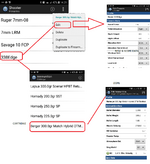Bronze Lifetime
- Messages
- 11,321
- Reactions
- 25,945
You do Bernoulli calculations on the fly? I'm impressed!I still use one for properly sizing ductwork...
Follow along with the video below to see how to install our site as a web app on your home screen.
Note: This feature may not be available in some browsers.
You do Bernoulli calculations on the fly? I'm impressed!I still use one for properly sizing ductwork...
You do Bernoulli calculations on the fly? I'm impressed!

Paid app?shooter
Yes, $9.99Paid app?
Yes, $9.99
Here's the publisher website. Shooter - Ballistics Calculator for iOS and Android
You can also edit your rifle and dope information in the cloud using your computer. Then when you install it on a new android device, you just reload the data from the cloud.
[edit to add] I've also purchased Strelok. Both apps work great, prefer Shooter.
Paid for it many years ago, forgot that I had actually bought it, whenever I go to Google Play it automatically downloads fully authorized. Plus, zero recurring charges, unlike On X Hunt.One time charge? Hopefully not a monthly thing.
That's easy, metric is better. Moving the little decimal point is lot easier than learning and using 1/2", 1/4", 1/8" 1/16", 1/32", 1/64", 1/128" and inches, feet, yards, mile.The sooner this country accepts that and switches the sooner our kids can compete in mathematics.
"Mil" has nothing to do with "military." It is an abbreviation for milliradian, 1/6400 of a degree in angular measure. That's 3.6 inches at 100 yards, or 3 feet at l,000 yards.
Mil/Mil for me.